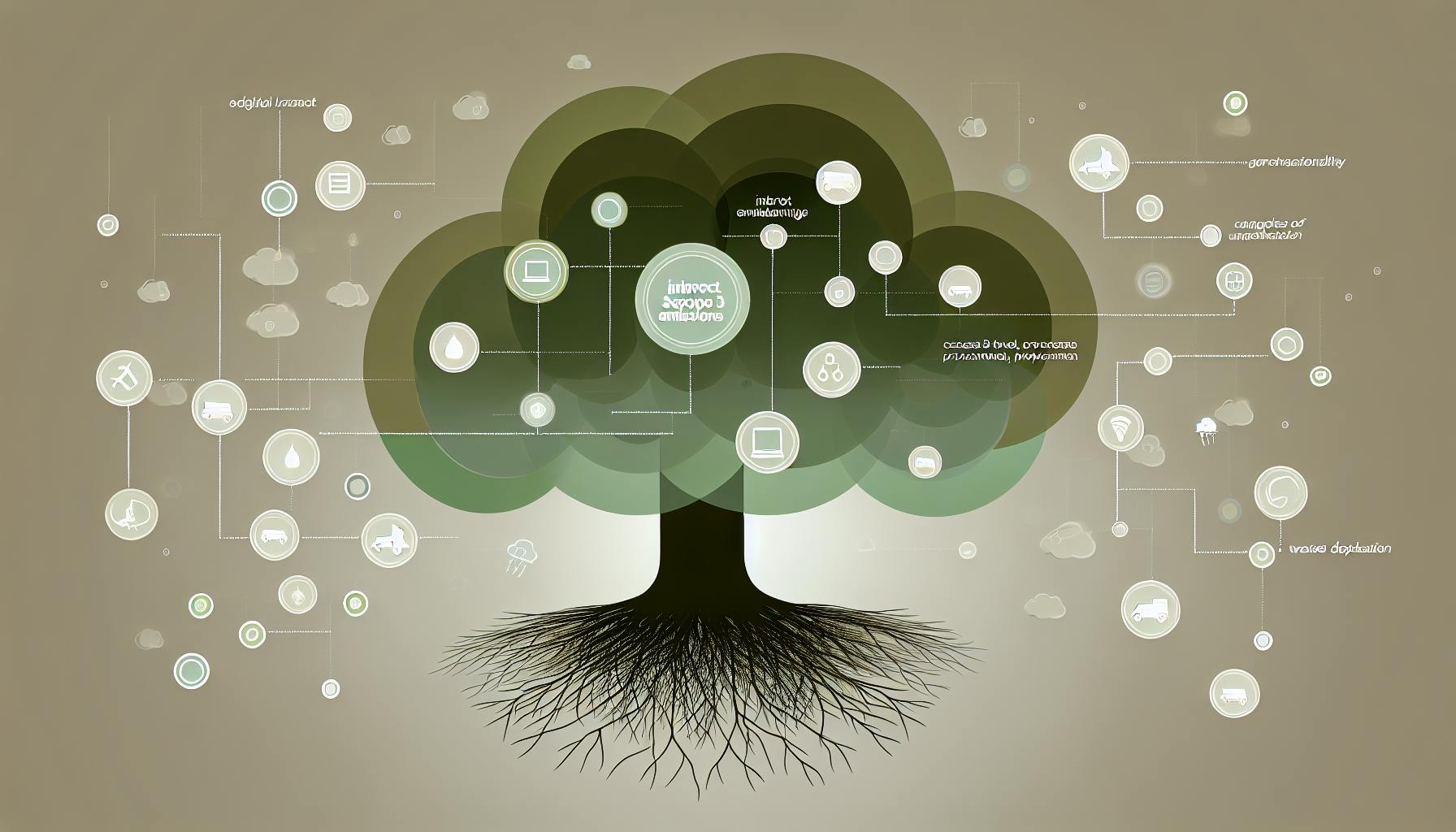With corporate sustainability becoming increasingly important, most companies would agree that accurately measuring their carbon footprint is essential.
By leveraging the right carbon accounting software, businesses can gain comprehensive visibility into their greenhouse gas emissions and identify opportunities to reduce their environmental impact.
In this post, we will explore the key factors to consider when selecting a carbon accounting platform, including scalability, integration capabilities, and user-friendliness to empower effective carbon management.
Introduction to Carbon Accounting Tools
Carbon accounting tools play a critical role in helping companies measure, report, and reduce their greenhouse gas (GHG) emissions. As sustainability becomes an increasing priority, these tools provide the foundation for corporate climate strategies.
Understanding the Role of Carbon Accounting in Corporate Sustainability
Carbon accounting involves quantifying a company's total GHG emissions across all business operations. This includes:
- Scope 1 - Direct emissions from sources owned or controlled by the company (e.g. vehicles, facilities)
- Scope 2 - Indirect emissions from purchased electricity/heating
- Scope 3 - All other indirect emissions from the company's value chain
By tracking emissions across these scopes with carbon accounting software, companies can:
- Identify the largest sources of emissions to focus reduction efforts
- Benchmark against past performance or industry peers
- Comply with climate disclosure mandates
- Communicate sustainability progress to stakeholders
This environmental transparency and action is key for meeting stakeholder expectations around social responsibility.
Exploring the Best Carbon Accounting Software for Business
With many carbon accounting tools now available, the best solutions provide:
- Comprehensive tracking - Monitor all emission sources across scopes 1, 2 and 3
- Customizability - Flexible to adapt to a company's unique operations and data
- Automation - Seamlessly integrate with existing data sources and workflows
- Reporting - Tools to analyze trends and create investor-grade disclosures
Top software choices offer user-friendly interfaces alongside robust analytics for data-driven insights.
The Importance of Accurate Carbon Footprint Calculations for Businesses
The foundation of any carbon strategy is an accurate understanding of a company's carbon footprint. Carbon accounting tools enable:
- Precise measurement following accepted GHG accounting standards
- Regular footprint assessments to identify variability and hotspots
- Context around emissions relative to business growth and targets
With reliable carbon footprint data, companies can confidently develop science-based plans to reduce emissions in line with climate goals.
What are carbon accounting tools?
Carbon accounting tools are software solutions designed to help companies measure, analyze, report on, and reduce their greenhouse gas (GHG) emissions and overall environmental impact. These tools serve a key role in corporate sustainability initiatives by providing the data and insights needed to set carbon reduction goals, track progress, and make strategic decisions.
At a high level, carbon accounting tools enable users to:
- Calculate their carbon footprint across Scopes 1, 2, and 3
- Identify the largest sources of emissions across their operations and supply chain
- Model different decarbonization scenarios and set science-based targets
- Track performance against goals over time
- Generate comprehensive emissions reports for both internal and external stakeholders
Core capabilities offered by leading carbon accounting platforms include:
- Data collection and management: Tools to gather emissions data from various sources, integrate with existing data systems, and maintain organized inventories.
- Calculation engines: Built-in methodologies and formulas for computing GHG emissions by activity data and emission factors.
- Visualization and analysis: Interactive dashboards and analytics to slice, dice, and spot trends in emissions data.
- Reporting and disclosure: Customizable report templates and automated reporting workflows.
- Target setting: Functionality to develop short and long-term emissions reduction targets.
- Action planning: Roadmapping features to build data-driven decarbonization strategies.
- Verification: Credible assurance of methodology, data accuracy, and effective internal controls.
To summarize, carbon accounting tools empower enterprises to take control of their environmental footprint, enabling the measurement, management, and reduction of GHG emissions. As sustainability climbs higher on the corporate agenda, these platforms provide the foundations for science-based climate action.
What is the carbon accounting method?
Carbon accounting is the process of measuring and reporting on the greenhouse gas (GHG) emissions from an organization's operations and value chain. It involves calculating emissions across all relevant sources, categorizing them into scopes, and tracking performance over time.
Some key things to know about carbon accounting methods:
-
They quantify GHG emissions using established measurement protocols like the Greenhouse Gas Protocol to ensure standardized and consistent calculations. Common emissions sources tracked include energy use, transportation, waste, etc.
-
Emissions are categorized into three scopes based on where they occur in the value chain:
- Scope 1 covers direct emissions from owned or controlled sources like facilities, vehicles, equipment.
- Scope 2 covers indirect emissions from purchased electricity/steam.
- Scope 3 includes all other indirect emissions from activities like procurement, distribution, investments, etc.
-
Tracking is done by collecting activity data, multiplying by emissions factors, and allocating across scopes. This allows the tracking of performance over time. Goals can be set to reduce emissions.
-
Reporting and disclosure occurs through annual sustainability reports and voluntary registries like CDP. This drives transparency and accountability.
In summary, carbon accounting provides the measurement infrastructure needed for organizations to understand, track and manage their climate impacts. Robust carbon accounting methods are key to driving decarbonization across the global economy.
What is the world's most widely used carbon accounting method?
The GHG Protocol developed by the World Resources Institute (WRI) and the World Business Council for Sustainable Development (WBCSD) provides the most widely adopted international carbon accounting standards.
Specifically, the GHG Protocol Corporate Accounting and Reporting Standard serves as the foundation for nearly every corporate greenhouse gas reporting program globally. Some key features that make it the global standard include:
-
Comprehensive Guidance: The standard includes detailed methodology and guidance for companies to prepare a complete corporate-level greenhouse gas emissions inventory. This covers emissions across all Kyoto gases, direct and indirect emission sources, and the entire value chain.
-
Flexible Framework: While comprehensive in scope, the standard provides flexibility for companies to tailor inventory boundaries, data collection approaches, emission factors, and reporting formats based on their capabilities and goals.
-
Global Acceptance: The GHG Protocol standard has been widely accepted as the basis for popular carbon reporting programs like CDP (formerly Carbon Disclosure Project) and regulatory frameworks like ISO 14064. Over 90% of Fortune 500 companies that report emissions data use the GHG Protocol.
In summary, the GHG Protocol Corporate Standard's extensive guidance, flexible framework, and global adoption make it the most widely used international carbon accounting method today. Companies worldwide rely on it as a consistent and credible approach to measure, manage and report on their greenhouse gas emissions and climate impact.
sbb-itb-c2a0016
What is the formula for carbon accounting?
The basic formula for carbon accounting is:
GHG emissions (CO2e) = Activity data x Emission factor
Where:
-
GHG emissions (CO2e): The carbon dioxide equivalent (CO2e) of total greenhouse gas emissions generated from an activity. This is expressed in metric tons or kilograms.
-
Activity data: A quantitative measure of the scale of an activity that results in GHG emissions. Examples are liters of fuel consumed, kilowatt-hours of electricity used, tons of waste generated, miles traveled, etc.
-
Emission factor: A coefficient that converts activity data into GHG emissions based on standardized calculations. It represents the GHG emissions per unit of activity data. Emission factors vary based on the source of emissions.
To calculate a carbon footprint, you multiply the activity data associated with various emission sources by their respective emission factors. This sums up all scope 1, 2, and 3 emissions into a single CO2e figure.
For example, a company consuming 10,000 kWh of grid electricity with an emission factor of 0.45 kg CO2e/kWh would have a footprint of 4,500 kg CO2e (10,000 x 0.45) just from purchased electricity.
Emission factors are often derived from life cycle assessments (LCAs) of products and services. LCAs account for emissions across the entire supply chain. For complex goods and services, calculating emission factors involves modeling multiple processes from raw material extraction to end-of-life. Simplified emission factors are also published by reputable bodies like government agencies. Over time, emission factors can get updated as industrial processes evolve to reflect the latest real-world conditions.
Evaluating Carbon Accounting Software: A Comparison Approach
Carbon accounting software provides businesses with the tools to measure, analyze, and reduce their carbon footprint. As climate change initiatives gain momentum globally, the market for these solutions is rapidly evolving. Companies that implement carbon management platforms early can gain significant competitive advantage.
When selecting a carbon accounting solution, key criteria to evaluate include:
Carbon Accounting Software Market Overview
The carbon accounting software market is projected to grow at over 12% CAGR from 2022-2030. Key drivers include government policy, investor pressure, and changing consumer preferences. Major players include Sphera, Enablon, CarbonView, and Persefoni. Most solutions offer carbon calculation, tracking, reporting and offsetting capabilities. As regulations tighten, advanced analytics and scenario planning features will provide greater value.
Scalability and Flexibility of Carbon Management Platforms
As a business evolves, so do its sustainability needs. Prioritize platforms that can scale based on changing emission sources, operating locations, and reporting requirements. Cloud-based software offers more flexibility compared to on-premise systems. Evaluate if the solution has pre-built integrations with major enterprise resource planning (ERP), customer relationship management (CRM), and other systems.
Integration Capabilities with Existing Systems
Manual data collection and carbon accounting can become extremely tedious. Solutions that integrate with existing data sources through APIs streamline this process significantly. They pull required activity data from sources like utility bills, fleet telemetry, supply chain software etc. This automates data collection and minimizes manual entry.
How to Calculate Carbon Footprint of a Company Using Software
Carbon management software calculates emissions using activity data and emission factors. The system should allow setting organization-specific factors that reflect actual operations. It should also include the latest emission factors from reliable sources like IPCC, EPA, and DEFRA. Advanced solutions offset unavoidable emissions and provide detailed reports for disclosure.
User-Friendliness of Carbon Tracking Software
An intuitive, easy-to-use interface ensures high software adoption across the organization. Evaluate whether the platform requires extensive training for basic functions like data input and report building. Graphical dashboards that visualize carbon data can greatly enhance user experience. They identify high emission areas and track progress.
In summary, carbon accounting tools empower businesses to set science-based targets and align operations with global climate goals. An ideal solution should have strong analytics, be user-friendly, scalable, and integrate with existing company software.
Comparing Top Carbon Accounting Platforms
Carbon accounting platforms provide businesses with tools to measure, analyze, and reduce their carbon footprint. As companies increasingly prioritize sustainability, the market for these platforms continues to grow. When selecting a carbon accounting solution, key factors to consider include:
Features and Benefits of Best Carbon Accounting Tools
The top carbon accounting platforms share some common features, while also providing unique capabilities:
-
Calculation engines: All platforms include emissions calculation engines to analyze scope 1, 2, and 3 emissions based on activity data inputs. More advanced tools like Carbon List's directory provide access to multiple calculation methodologies.
-
Custom reporting: Most platforms enable custom emissions reports that can be tailored to different audiences and compliance needs. Carbon Analytics, for example, has flexible reporting tools to build reports covering different geographies, business units, or time periods.
-
Data integrations: Leading solutions integrate with various data sources like utility bills, travel provider data, supply chain emissions, etc. to automate data collection. Persefoni offers many out-of-the-box integrations via API.
-
Compliance mapping: Some software like Enablon can map emissions data to major reporting programs and help businesses comply with regulations like GRI, CDP, TCFD, and SEC rules.
Carbon Accounting Platform Scalability and Customization
When evaluating carbon accounting tools, assessing their flexibility to match current needs and future business growth is key:
-
User access: Solutions like SAP Carbon Footprint Analytics provide role-based access for different teams to input or view emissions data. Admin controls over user permissions are important.
-
Data volume: The ability to handle large, enterprise-scale emissions data volumes without performance issues is critical. Persefoni and Enablon offer robust data management capabilities.
-
Customization: Platforms that enable white-labeling of reports, custom data fields, and workflows aligned to a company's structure offer more flexibility. Carbon Analytics has highly customizable features.
Carbon Footprint Software for Comprehensive Emissions Tracking
For holistic carbon management, companies need software covering all scopes of emissions:
-
Scope 1 and 2 tracking: All leading platforms calculate scope 1 fuel usage and scope 2 electricity emissions. SAP Carbon Footprint Analytics also tracks scope 1 process emissions.
-
Scope 3 supply chain analysis: Solutions like Persefoni model indirect scope 3 emissions from purchased goods, transportation, waste, and other activities. This enables supply chain engagement.
-
Offset integration: Some tools like Watershed facilitate the carbon credit purchase process to offset residual emissions.
-
Lifecycle analysis: Platforms like Sphera offer emissions lifecycle analysis for assessing products and materials emissions cradle-to-grave.
Carbon Reporting Software and Compliance Features
With tightening regulations around climate risk disclosures, carbon reporting capabilities are essential:
-
Disclosure mapping: Solutions like Enablon's ESG platform help companies align reporting to major disclosure programs like CDP, GRI, and TCFD.
-
Investor-grade analytics: Leading software like Persefoni enables detailed, auditable reports of carbon performance for shareholders and lenders.
-
Regulatory compliance: Tools with compliance checklists, emission factor databases tied to local regulations, and report templates simplify meeting regulatory obligations. SAP Carbon Footprint Analytics enables compliance in 100+ countries.
In summary, today's carbon accounting platforms offer many options for companies pursuing science-based climate strategies. Assessing reporting needs, scalability requirements, and functionality against current and future ambitions is key to selection.
Implementing Carbon Management Solutions
Implementing an effective carbon management solution requires securing buy-in from key stakeholders, ensuring data quality for carbon footprint calculations, customizing the system to meet business needs, and training users for adoption.
Securing Stakeholder Buy-In for Sustainability Software
Gaining support from leadership and employees is critical when rolling out a new sustainability software system. Consider these tips:
- Present the business case showing cost savings and competitive advantage
- Highlight customer and investor demand for emissions reductions
- Provide examples of pioneers in your industry using these tools
- Emphasize it will integrate with existing systems and workflows
- Offer incentives like workplace green teams and recognition programs
Ensuring Data Quality for Company Carbon Footprint Calculations
Quality data is crucial for accurately calculating and tracking your company's carbon footprint over time. Follow these best practices:
- Carefully select data sources and collect consistent, complete emissions data
- Clean data to remove errors through validation rules and manual reviews
- Maintain thorough documentation of data management procedures
- Automate data collection via sensors, integrations and reporting dashboards
- Regularly review for gaps, outliers and opportunities to expand data sources
Customization and Configuration of Carbon Management Systems
Configuring the software to model your organization's structure and processes ensures rapid user adoption and impactful carbon management.
- Map features to current business workflows to minimize disruption
- Adjust setup of emissions factors, materials tracking and visualizations
- Integrate with existing sustainability data sources and reporting tools
- Train dedicated admins on customization features to enable self-sufficiency
Training and User Adoption for Environmental Software
The key to success is ensuring all employees understand and fully utilize the sustainability software.
- Schedule hands-on training sessions with role-based example scenarios
- Create quick-start guides, videos and FAQs tailored to each user profile
- Set organization-wide GHG reduction targets and showcase individual contributions
- Maintain an open feedback channel to address issues, enhance features and drive engagement
With stakeholder alignment, quality data, customization and training, your carbon management implementation will deliver robust analytics to inform impactful emissions reductions.
Conclusion and Next Steps in Carbon Management
Carbon accounting tools play a pivotal role in enabling organizations to measure, understand, and reduce their carbon footprint. As highlighted in this article, key factors to consider when selecting a carbon accounting platform include:
Summarizing Carbon Accounting Tool Selection Criteria
- Scalability - The ability to handle current and future emission sources as your business grows
- Accuracy - Precision in carbon calculation methodologies and data processing
- Customizability - Flexibility to tailor the platform to your business's specific needs
- Data integration - Capability to connect with existing data sources to automate data collection
- Reporting - Insights, visualizations, and exportable reports to share progress and meet compliance
Developing a Roadmap for Carbon Management Software Implementation
Successfully rolling out a carbon accounting platform requires cross-functional collaboration and planning:
- Conduct stakeholder interviews to define software requirements
- Shortlist vendors and pilot top contenders
- Develop an implementation timeline and communication plan
- Provide end-user training and support materials
- Continuously gather feedback to refine the platform
Future Trends in Carbon Accounting Software Market
As climate change initiatives gain momentum, we can expect to see:
- Increased adoption across industries and geographies
- Integration with financial planning and risk analysis
- More predictive analytics and scenario modeling capabilities
- Emergence of carbon accounting solution ecosystems
While selecting the right software is an important first step, focusing on effective change management and usage is key to realizing the sustainability benefits over the long term.


